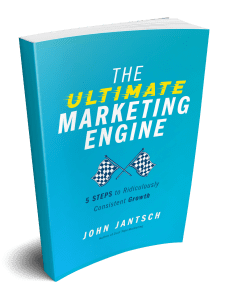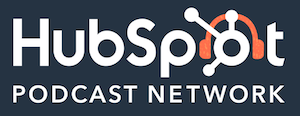[fusebox_track_player url=”https://traffic.libsyn.com/secure/ducttape/DTM-UME-Step3.mp3″ title=”Narrowing Your Focus On Your Ideal Customer” social_linkedin=”true” social_pinterest=”true” social_email=”true” ]
Marketing Podcast with John Jantsch
 In this episode of the Duct Tape Marketing Podcast, I’m doing part three of a three-part series talking about my new book launching Sept. 21, 2021 — The Ultimate Marketing Engine: Five Steps to Ridiculously Consistent Growth. I’m diving into step three – narrowing your focus and identifying your ideal customer.
In this episode of the Duct Tape Marketing Podcast, I’m doing part three of a three-part series talking about my new book launching Sept. 21, 2021 — The Ultimate Marketing Engine: Five Steps to Ridiculously Consistent Growth. I’m diving into step three – narrowing your focus and identifying your ideal customer.
![]()
![]()
Key Takeaway:
There are plenty of customers to go around. Just remember that you don’t need them all and maybe more important you don’t want them all. Not all customers are ideal – but saying no is maybe one of the scariest things there is for a business owner.
In this step, we’ll work on understanding who and what makes a perfect customer for your business. Then we’ll go to work on helping more of them understand why your business is the only logical solution for them to consider.

Topics I cover:
- [1:14] Where to listen to step one – mapping out where your best customers want to go and step two – finding the real problem your business solves
- [1:56] Why focus on the top 20% of your customers
- [6:57] Ranking your customers by profitability not solely revenue
- [8:14] Focusing on your best customers who are not only profitable but who also refer your business
- [9:00] Crafting a message that tells the world this is who we serve
- [9:41] If you’re trying to appeal to everyone, you turn yourself into a commodity
- [11:26] Why you need to hone in on who you can deliver the most value to
More About The Ultimate Marketing Engine:
- Part one – Mapping Out Where Your Best Customers Want To Go
- Part two – Finding The Real Problem Your Business Solves
- Get access to the Companion Course
- Get yourself a copy of the new book
- Learn more about The Ultimate Marketing Engine: Five Steps to Ridiculously Consistent Growth
More About The Certified Marketing Manager Program Powered By Duct Tape Marketing:
Like this show? Click on over and give us a review on iTunes, please!

This episode of the Duct Tape Marketing Podcast is brought to you by the HubSpot Podcast Network.
John Jantsch (00:01): Hey, is it duct tape marketing listener? We know you're always on the lookout for ways to more efficiently scale your business. That's why I'm so excited to chat about. I digress another show on the HubSpot podcast network. Troy Sandra is the host of I digress, talks all about how you can eliminate complexity, complications and confusion from your business equation and create clarity to streamline strategy solutions that achieve scalable and sustainable success. Check out episode 24, start there 14 minutes or so. Strategy is power. You know, I love that idea. So listen, learn and grow with I digress on the HubSpot podcast network at hubspot.com/podcast network.
John Jantsch (00:57): Hello, and welcome to another episode of the duct tape marketing podcast. This is John Jantsch. . I'm doing another solo show around the launch of my new book, the ultimate marketing engine five steps to ridiculously consistent growth. I'm going to cover step number three today. If you did not catch step number one and number two, you can go backwards. We'll link to them in the show notes as well@ducttapemarketing.com. But if you want to pick up the book now it's available. By the time you're listening to this, you can get it at any of your favorite book sellers. It's just the ultimate marketing engine.com. You can find out all about it. So let's dive into step three in the previous couple of sessions, I've read the intro to the step directly from the book. So I'm going to do that again today. Step number three is narrow your focus.
John Jantsch (01:44): There are plenty of customers to go around. Just remember that you don't need them all and maybe more important. You don't want them all in this step. We'll work on understanding who and what makes a perfect customer for your business. Then we'll go to work on helping more of them. Understand why your business is the only logical solution for them to consider. I'm going to suggest that you narrow to the top 20%, I guess mainly 20% is a nice round number, but there's also plenty of scientific data suggesting that somewhere around 80% of a typical businesses, revenue or profit is found in just 20% of its customers. I know that the 80 20 model or parades principle often seems to oversimplify business operations, but then again, it just keeps ringing true in math and economics and land ownership, sports, and yes, most businesses.
John Jantsch (02:42): Let's say that right now. You had the chance to Chuck all of your current customers and proclaim. I can work with anyone I want to work with. Would you still be working with today's customers experience tells me that your answer would be maybe some, probably not all sure. You know that all, not all customers are ideal, but what the heck shouldn't you sell to anyone who needs what you offer isn't anyone with the means to pay for what you sell an ideal customer. And you probably know the answer to those questions is no, but saying no is maybe the scariest thing there is for a business owner. You check your email first thing one morning, and there's a message from a long time customer introducing you to a colleague of theirs who says they need some help with kind of what you do. Nice referrals are awesome, right?
John Jantsch (03:32): You immediately reach out to this would be new customer. And it turns out that they work for a small department of a fortune 500 company and that what they need is something you've never done before, but let's the same, but there is an RFP process and you'll have to go through several rounds of vetting with the purchasing department. Before you would present your proposal to the merchandising team, your best customers are business founders who make their buying decisions independently, who work mostly via verbal agreements and an easily definable set of deliverables and expectations. But now all of a sudden you're chasing what feels like a big opportunity. I'll do you have little experience with what they need few processes in place to navigate the sales path and very little idea how much staff time would even go into pricing this engagement? It sounds like a made up scenario.
John Jantsch (04:24): You know, it's happened to me numerous times and it happens in some form to most every business out there. We want the business. It seems like we could figure it out, but time and time again, we underestimate how much it costs us to chase a customer who is not a good fit. There's a great strategic question from Michael Bungay stainers, the coaching habit that every entrepreneur business owner marketer or salesperson needs to pin up somewhere in full view. If I'm saying yes to this, what am I saying no to all right. So in this step, I'm asking you to narrow your focus and I've picked an arbitrary number two, the top 20% of your customers. So how do you do that? How do you even figure out who they are? A lot of times, people just default to our top customers are our biggest customers by revenue.
John Jantsch (05:17): And that may actually be a useful way to measure who they are. But experience also tells me, it may not. In fact, in some cases, a that bigger customer that you had to cut a deal to get the business and who demands a lot and makes you go out of your way to do certain processes, even makes it hard to get paid. They may be big in terms of revenue, but they may not actually be that profitable. And now let's hear a word from our sponsor. HubSpot CRM platform is easy to adopt, and there are really two reasons. Two features that make this possible, that contact timeline and the mobile app and mobile keyboard HubSpot's contact timeline gives you the historical context. You need to get the work done to connect with customers because all of your customer data is in one place. It can serve as a single source of truth.
John Jantsch (06:05): In HubSpot, you can take an action, right from the contact timeline, make a call and roll a contact in a sequence, schedule a meeting. You've got it. And if you're on the go, you just use the mobile app to make it all happen and keep everything up to date. You don't even have to spend a lot of time training your team. You could be sure that all the contact information is going into one system, making your team more efficient, look better adoption with a CRM leads to better data, richer insights, and a bigger impact on your customer experience. Learn more about how you can scale your company without scaling complexity@hubspot.com. So what I suggest that folks do, and again, pointing to the book, the ultimate marketing engine.com. If you order the book, you're going to get resources that help you through some of the steps.
John Jantsch (06:53): And I'm going to suggest some checklists and forms and tools that we use. But what we ask our clients to do is to think about ranking their customers today by profitability, not just revenue, sometimes those match up, but a lot of times they don't. If you have thousands and thousands of customers, this is a, a little more of grouping or creating Stratus of a customers. B customers see customers. If you have 50 or less, you may actually know all your customers by name and be able to really rank exactly what you did. What we find is that when people do this work in one fashion or another, they start to see work. That's not profitable. They start to see industries that they serve a lot, that they didn't realize that developed a niche in a couple industries without even knowing it. So all of that is, is actually very useful.
John Jantsch (07:40): But in many cases, you also start seeing some clients that you should, or some types of business, you shouldn't chase. If most of your profit is coming from two or three services that you offer. And yet your website has a list of 27 that you could offer, or you maybe have offered, or maybe somebody asked you for one, one time. You probably should take those off. You should probably focus on the ones that are the most profitable. If nothing else, you're going to send a signal to the world and let's face it to Google that this is what your business is about. These three or two or three core things that really make your money. Now, I also want you to think in terms of after you rank these clients by profitability, I also want you to think in terms of, do any of them currently refer business to you today?
John Jantsch (08:24): A customer that is profitable probably has the right problem, probably has the right behavior. And it was a good fit. If they're also referring business to you, it's a pretty good sign that they really like what you do. They like your team. They've had a great experience. And that combination understanding all of the characteristics, all of the ideal behaviors of that group is how you start narrowing your focus and how you start focusing. Not only on what more you could do for that group, but focusing your messaging on telling the world that this is who we serve. Now at first, it may feel like you're also saying this is who we don't serve and you are. And, and that's a good thing. I think that could feel scary because you, you may be effectively cutting off some business that, Hey, they, they said, they'd pay you today.
John Jantsch (09:15): But as I referenced in the section that I read, I think we underestimate chasing today's dollar. We underestimate the future opportunity costs or loss in, in doing that by not being seen as the go-to person for a certain industry or for a certain niche, you really water down what it is, your message. And you water down, frankly, your pricing, because if you're trying to be all things to all people, you effectively put yourself into commodity field, which is where people are going to then shop on price. But when you are able to focus on what you do and what you actually do better than anyone else for a very specific definable ideal client, you are able to charge a premium. In fact, people expect to pay a premium for what it is that you do. Now. We, some of the worksheets that we include on the companion site actually help you start identifying must have, and nice to have an ideal behavior.
John Jantsch (10:16): So you can really start narrowing down to what a lot of marketers call personas or just really narrowly defining. Now, one of the things that, that is really common advice for a lot of folks out there, especially people just getting started. I think this is bad advice. She, you might hurt the riches are in the niches. Again, I would say niches because that's how I say it, but it doesn't rhyme then. So the riches are in the niches and that's terrible advice. There, there can be a lot of very practical reasons for getting good at creating repeatable systems to serve people with certain needs charging more because you are specialists in their industry. Those are all good things, but where I see the advice go wrong for a lot of folks is that they just look at an industry or they look at a niche as an opportunity.
John Jantsch (11:00): They dive into it. And then they find that it's not really the opportunity they thought, or maybe they just don't even like working with, uh, the folks in that industry, or they're just not a good match from a beliefs and value standpoint. And so then they're faced with starting over again. So one of the things that that I think is often not talked about in trying to narrow your focus and I IDI identify who your ideal customer or client is to think long and hard about who can you deliver the most value to. And let me add another variable, the fastest, what niche, or what segment of your market that you serve today, do you deliver the most value to the fastest? And the reason I want you to consider that is that's really what makes a great fit delivering value for somebody is going to almost guarantee that they have a great experience is almost going to guarantee that you can raise your prices.
John Jantsch (11:58): It's almost going to guarantee that folks are going to want to refer or evangelize your business. Some percentage of that group would love to do 10 times more business with you. If you discovered how to deliver even more value. And then another group, another small percentage of that group might do a hundred times more business with you. If you discovered how to deliver even more value for them in step number one, I talked about this customer success track, and that really gets into the heart of this idea of, of laddering up of creating more stages and more products and service offerings. But only for that ideal customer that already trusts you. That's already had a great experience with you that you're already delivering value to that's who you can do more with. That's how you scale your business with your customers rather than chasing every new opportunity.
John Jantsch (12:55): That's it. You can find out more on this@theultimatemarketingengine.com. By the time you listen to this, the book will be out everywhere available in all stores. Don't forget, we've got this companion site. That's going to give you all the resources in the book as well. Take care. All right, that wraps up another episode of the duct tape marketing podcast. I want to thank you so much for tuning in, feel free to share the show, feel free to give us reviews. You know, we love those things. Also, did you know that we had created training, marketing training for your team? If you've got employees, if you've got a staff member that wants to learn a marketing system, how to install that marketing system in your business, check it out. It's called the certified marketing manager program from duct tape marketing. You can find it at duct tape, marketing.com and just scroll down a little and find that tab that says training for your team.
Speaker 2 (13:55): [inaudible].
Sign up to receive email updates
Enter your name and email address below and I'll send you periodic updates about the podcast.

